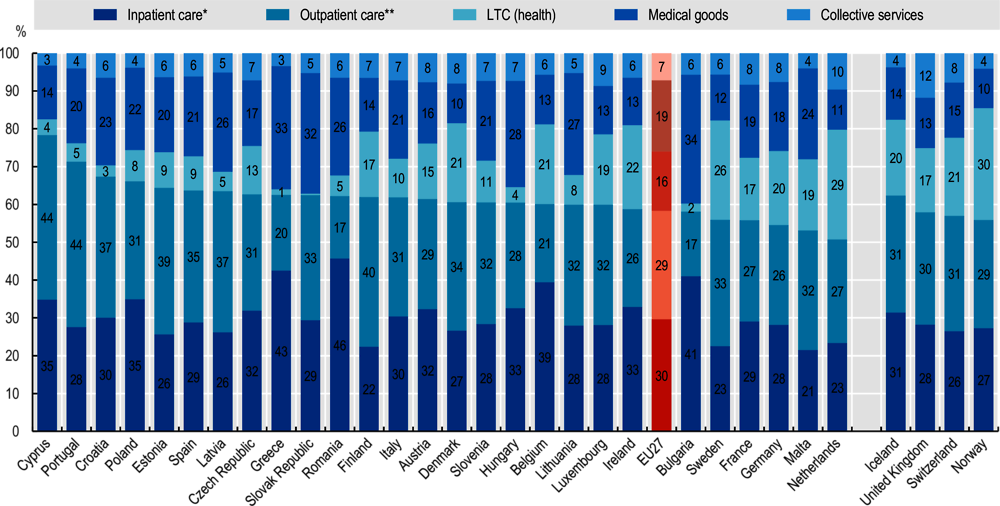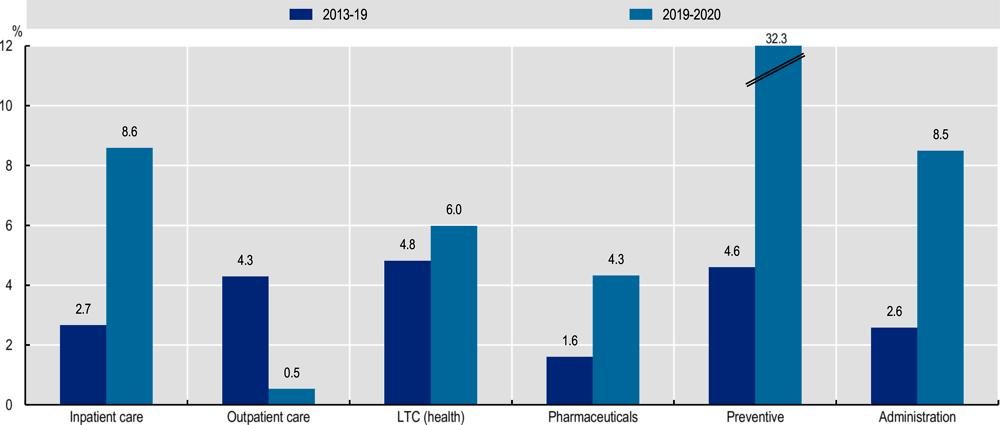Health expenditure by type of good and service
A variety of factors, from disease burden and system priorities to organisational aspects and costs, help determine the allocation of resources across the various types of health care goods and services. In 2020, the EU spent around three-fifths of its total health spending on curative and rehabilitative care, around 20% on retail medical goods, and one-sixth on health-related long-term care. The remaining 7% was spent on collective services, such as prevention and public health, as well as the administration of health care systems (Figure 5.9).
In 2020, the share of current health expenditure going to curative and rehabilitative care ranged from just over half of all health spending in Malta and the Netherlands to around three-quarters in Cyprus and Portugal. Breaking it down further, Romania had the highest proportion of spending on inpatient care (including day care in hospitals), accounting for 46% of health spending. For most EU countries (16), spending on outpatient care (including home-based curative and rehabilitative care and ancillary services) exceeded that on inpatient care.
The other major category of health spending is retail medical goods (mainly pharmaceuticals) consumed in outpatient settings. In 2020, the share of medical goods spending was highest in Bulgaria, the Slovak Republic and Greece, where it represented around a third of health spending. In contrast, Denmark, Sweden and the Netherlands spent only 10-11% of total health spending on medical goods.
Countries’ spending on health-related long-term care also varies considerably across the EU. The Netherlands, Sweden and Norway allocated more than a quarter of their health spending to long-term care in 2020. In many Southern as well as Central and Eastern European countries, with more informal arrangements, expenditure on formal long-term care services accounts for a much smaller share of total spending.
Figure 5.10 compares the per capita spending growth rates for key health goods and services for the years 2013-19 with 2019-20 across the EU. Prior to the COVID-19 crisis, spending growth for inpatient care, pharmaceuticals, and administration averaged around 2-3% per year, while annual spending increases for long-term care, outpatient care, and prevention averaged above 4%. In 2020, the pandemic triggered exceptional spending growth for most health care functions. Spending on preventive care increased by nearly one-third, with countries dedicating resources to testing, tracing, surveillance, and public information campaigns related to the pandemic. Spending growth on inpatient care reached nearly 9%, driven by COVID-19-related expenditures including additional staff and input costs (e.g. personal protective equipment) and substantial subsidies targeted at hospitals. Only outpatient care experienced lower growth in 2020 compared to the 2013-19 period. This can be attributed to the deferral of visits to outpatient facilities during the pandemic, in efforts to reduce transmission and free up health system capacity.
The System of Health Accounts defines the boundaries of the health care system. Current health expenditure comprises personal health care (curative and rehabilitative care, long-term care, ancillary services and medical goods) and collective services (prevention and public health services as well as health administration). Curative, rehabilitative and long-term care can also be classified by mode of provision (inpatient, day care, outpatient and home care). Concerning long-term care, only care that relates to the management of the deterioration in a person’s health is reported as health expenditure, although it is difficult in certain countries to clearly separate out the health and social aspects of long-term care.
Some countries can have difficulties separating spending on pharmaceuticals used as an integral part of hospital care from those intended for use outside of the hospital, potentially leading to an underestimate of pharmaceutical spending and an overestimate of inpatient and/or outpatient care.



